Ho’s Hanoi
Authored By Brian
I worked hard to not title this first post from Hanoi, “Good Morning, Vietnam!”
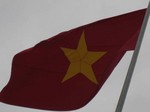 We’re in Hanoi, capital of Vietnam, home to some 3 of the 83 million total people living in this country. After landing late on Friday, we caught a taxi for $12 to go the 45km from the airport into the Old Quarter of Hanoi. We arrived just before midnight and hit the sack, stoked that our room was just $20 for the night and was quite nice and clean. For our first night, we stayed at a Lonely Planet-recommended hotel, Star Hotel. More on the Lonely Planet syndrome shortly.
We’re in Hanoi, capital of Vietnam, home to some 3 of the 83 million total people living in this country. After landing late on Friday, we caught a taxi for $12 to go the 45km from the airport into the Old Quarter of Hanoi. We arrived just before midnight and hit the sack, stoked that our room was just $20 for the night and was quite nice and clean. For our first night, we stayed at a Lonely Planet-recommended hotel, Star Hotel. More on the Lonely Planet syndrome shortly.
Hanoi’s Old Quarter surrounds Hoam Kiem lake and is a maze of short streets, each featuring a specialty or two. For example, one street holds all of the bamboo ladders in town while another street is famous for silver smithing. Yet another has all of the handicrafts and near there is where you buy all of your home accessories like door handles and drawer knobs. We spent most of the day walking around and trying some food… Hanoi has a ton of good eating and all of it is in the $2-5 range. Although 16,000 Vietnamese Dong officially equals one of our greenbacks, US dollars are accepted (preferred?) basically everywhere. My first ATM withdrawl was a trip – I had finally graduated to millionaire status!
One of our first meals was Little Hanoi. The doors were smoked dark so you couldn’t see inside and as we opened the door and stepped inside, it was obvious this was a Lonely Planet recommendation. It was carbon copy group after group of travelers and not a local in sight. What made it funnier were the number of people who walked in after us with their LP guidebook actually in hand. There was a pause near the door, a recognition of what was going on and then usually a sheepish “man aren’t we sheep?” smile or chuckle as they are seated by the friendly staff there. LP is right – the food is good and the people are friendly but unlike NZ/AU where deviating from the guidebook requires zero thought, you can smell the Church of the Lonely Planet in a developing nation. Hint: it’s relatively wealthy and white. I inadvertently bought a second SE Asia guidebook from Moon while in Sydney and we’ve come to look at it more and more for recommendations as we know that it will be just a little more off the beaten path. We’re also finding that LP recommendations justify a 25-33% “tax” thanks to the hordes.
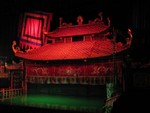
That night we saw a water puppet show near the lake. Water Puppetry is a peasant form of entertainment that has been codified and turned into mainstream entertainment for both locals and foreigners. A number of puppeteers stand waist-deep in water behind a bamboo curtain and use a series of clever pulleys and sticks to animate their puppets in front of the audience. Unlike with marionettes, all of the motion comes from below the water so the puppets look quite different. Each show is a little over an hour and contains more than a dozen short sketches about various farming and rural-life themes. There is a narrator character, music and dialogue that goes along with the show. We both thought this was really cool… very different from anything we have seen before.
Hanoi is the home and final resting place of Ho Chi Minh, known to the Vietnamese as “Uncle Ho”. Although he wished to be cremated, in-line with Buddhist beliefs, the Communists embalmed him like Lenin and put him on display in a mausoleum in the center of town. For 10,000 dong, you can take a look. Against Jennifer’s initial desires, we rented single-speed Chinese bicycles (the bike du jour) to get around and from the chaos of motorbikes, minibuses, taxis, cyclos and bicycles, we learned to ebb and flow with the two basic rules of the road:
- Might makes right; yield to all bigger vehicles
- Don’t make sudden changes in direction
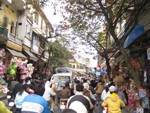 Because the city is as flat as the one-egg omelet served each morning in the guesthouses, riding around is easy and fast even without gears. The dominant ride is definitely the motorbike but everything on two wheels seems to go about the same speed. Cars tend to get snarled in unwieldy traffic and slowed up in many areas as motorbikes dart in, around and between everything in both directions. Unlike the teat of extensive rules and signage from which Western drivers depend on for motoring salvation, drivers from countries like Vietnam expect the unexpected, leading to a far more aware and cooperative road environment. Sure, horns constantly honk and lights regularly flash, but everyone gets where they need to go using the two available lanes in the most efficient pattern possible (sometimes 3 abreast in one direction; car passing truck passing motorbike with oncoming traffic flashing their high beams).
Because the city is as flat as the one-egg omelet served each morning in the guesthouses, riding around is easy and fast even without gears. The dominant ride is definitely the motorbike but everything on two wheels seems to go about the same speed. Cars tend to get snarled in unwieldy traffic and slowed up in many areas as motorbikes dart in, around and between everything in both directions. Unlike the teat of extensive rules and signage from which Western drivers depend on for motoring salvation, drivers from countries like Vietnam expect the unexpected, leading to a far more aware and cooperative road environment. Sure, horns constantly honk and lights regularly flash, but everyone gets where they need to go using the two available lanes in the most efficient pattern possible (sometimes 3 abreast in one direction; car passing truck passing motorbike with oncoming traffic flashing their high beams).
Full of confidence, we valeted our bikes at the Ho Chi Minh complex for a quarter each, grabbed a brochure and headed inside. Now, I’ll admit I didn’t pay much attention in history class and I am a bit ignorant on Vietnamese history and the background to the Vietnam war. But! Jennifer and I both thought we were on crack as the brochure described Ho Chi Minh as the founder of the Democratic Republic of Vietnam. We were both pretty sure he was a Commie.
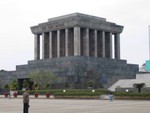 After fifteen checks from guards for cameras, hands in pockets, slow walking, hats on head, fast walking, talking and general non-conformist behavior, we wound our way through the granite building and through a small room with Ho in a softly-lit glass coffin. Given that he’s been dead for 30 years, he’s not looking too bad but the whole doll-mannequin look is not really for me. He still has his crazy beard though… the Russian doctors were able to keep that together. On the wall behind his resting place are two giant red stripes from floor to ceiling. The first has the yellow Vietnam star like on the flag which represents hope for the future. The second was the sickle and anvil of Communism. We knew something smelled fishy about the “Democratic Republic of Vietnam” and it just might be the Soviet formaldehyde.
After fifteen checks from guards for cameras, hands in pockets, slow walking, hats on head, fast walking, talking and general non-conformist behavior, we wound our way through the granite building and through a small room with Ho in a softly-lit glass coffin. Given that he’s been dead for 30 years, he’s not looking too bad but the whole doll-mannequin look is not really for me. He still has his crazy beard though… the Russian doctors were able to keep that together. On the wall behind his resting place are two giant red stripes from floor to ceiling. The first has the yellow Vietnam star like on the flag which represents hope for the future. The second was the sickle and anvil of Communism. We knew something smelled fishy about the “Democratic Republic of Vietnam” and it just might be the Soviet formaldehyde.
The rest of the Ho compound was pretty standard tourism fare stuff with a Communist slant on how prosperous and great the country is and how they defeated the Americans and so forth. What now seems typical in Vietnam was exemplified at the complex where Vietnamese(-looking) people are allowed into the museum area for free while foreigner(-looking) people have to pay several thousand dong. This price discrimination exists in most places and is perhaps most offensively propagated by the government. As recently as a couple of years ago, trains running from Hanoi to Ho Chi Minh charged foreigners 250% more for the same exact tickets.
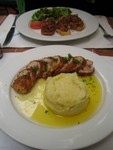 The rest of the day was about grossing ourselves out with awesome food. We ate at Hoa Sua, a culinary training academy for disadvantaged youth, which serves Western, French and Vietnamese cuisine.
The rest of the day was about grossing ourselves out with awesome food. We ate at Hoa Sua, a culinary training academy for disadvantaged youth, which serves Western, French and Vietnamese cuisine. 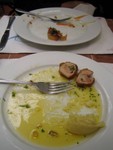 We tried a number of dishes including a haute cuisine version of Macaroni and Cheese, Foie Gras soup, Bruschetta and a stuffed pork with garlic and butter drenched mashed potatoes. There wasn’t much left.
We tried a number of dishes including a haute cuisine version of Macaroni and Cheese, Foie Gras soup, Bruschetta and a stuffed pork with garlic and butter drenched mashed potatoes. There wasn’t much left.
There was really only one thing to do next and that was get a massage. Jennifer is a massage champion – she’s had them in all fifty states and eleven foreign countries and her eyes rarely get as big as when she hears “Sports Club/LA” and “Spa” in the same sentence. I, on the other hand, have never had a professional massage. Nay, my only experiences with this “relaxing” activity are the tortuous shoulder massages my dad used to give us as kids. “Doesn’t that feel good?” he would ask to cries of pain and wincing. When told that I could pay $125 for an hour of that privilege, you’ll understand why I may have decided to pass. But here, at $6/hour, it couldn’t really hurt to try. So I did.
Jennifer and I were on tables next to each other while our 5’1” 100lb masseuses set about their work. Within minutes, the woman was standing on my back, rocking back and forth, cracking my vertebrae one by one. Jennifer rated hers a 4 out of 10 on her global massage scale while my rating was a simple, “what the hell?”
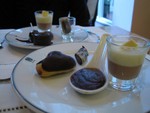 As an encore, we headed to the Sofitel Metropole Hotel for Tea. Tea and… an optional chocolate buffet! The Metropole is a turn-of-the-century French hotel that was renovated in the 90s and has rooms for $250/night and up. Given the cost of living in Vietnam, that’s like having a Chateau in France all to yourself. From 4 to 5:30 for $15 USD, we indulged ourselves in trying every kind of dark, milk and white chocolate we had ever seen. We had agreed this would be our dinner and we made nothing less than giant pigs of ourselves filling in the gaps with little tea sandwiches and fruit. We tried the ganache, the chocolate bread pudding and the chocolate fountains. And we went back for seconds. And thirds. And I think I had a small helping of fourths despite the ulcer-like pain and nausea I was experiencing from the 72,000 calories of sugar, butter and fat.
As an encore, we headed to the Sofitel Metropole Hotel for Tea. Tea and… an optional chocolate buffet! The Metropole is a turn-of-the-century French hotel that was renovated in the 90s and has rooms for $250/night and up. Given the cost of living in Vietnam, that’s like having a Chateau in France all to yourself. From 4 to 5:30 for $15 USD, we indulged ourselves in trying every kind of dark, milk and white chocolate we had ever seen. We had agreed this would be our dinner and we made nothing less than giant pigs of ourselves filling in the gaps with little tea sandwiches and fruit. We tried the ganache, the chocolate bread pudding and the chocolate fountains. And we went back for seconds. And thirds. And I think I had a small helping of fourths despite the ulcer-like pain and nausea I was experiencing from the 72,000 calories of sugar, butter and fat.
It was awesome.
Ok, let’s fast forward a bit. The next day, we took a 2-day trip to Halong Bay on the coast. Halong Bay was a leg on the last Amazing Race; it’s a bay full of karst (limestone) outcroppings that form some 3000 islands. They range from little boat-sized rocks sticking out of the water to 250-meter tall islands with cave systems, plant and bird life.
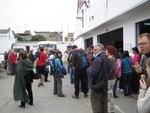 The weather was cold, gray and depressing. The bus ride to the coast took 3.5 hours despite being just 170km because the speed limit on the road is 45-60km and maintaining a speed over 50km is difficult as motorbikes come on and off the road at will and weave in and out of traffic. Having walked and bicycled around Hanoi and seeing relatively few white people, we weren’t really prepared for being suddenly thrust onto the packaged tour route. This is our rest stop for snacks and bathrooms; try to find the Vietnamese people in this picture!
The weather was cold, gray and depressing. The bus ride to the coast took 3.5 hours despite being just 170km because the speed limit on the road is 45-60km and maintaining a speed over 50km is difficult as motorbikes come on and off the road at will and weave in and out of traffic. Having walked and bicycled around Hanoi and seeing relatively few white people, we weren’t really prepared for being suddenly thrust onto the packaged tour route. This is our rest stop for snacks and bathrooms; try to find the Vietnamese people in this picture!
We walked around the corner to a couple of small stands and bought cokes and bananas. The price might not have been terribly cheaper for those items but at least we got to practice our Xing Chao (hello) and Cam On (thank you). The tour route turned out to be like this as well… what in the guidebooks was described as an easy place to build-an-itinerary-on-the-fly to visit and explore caves by flashlight, out boat basically followed the other 50 boats full of people to the same grottoes and landing points.
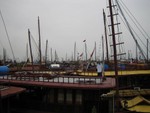 Speaking of landing points… there is no organized docking despite the heavy boat traffic. These guys run these modified junks straight into whatever sliver of land they can see and simply cram the other boats out of the way until either their nose reaches shore or they decide to have us jump on and cross the remaining boats between our ship and shore. It 100% matches the way they drive but it is comical nonetheless as they bash and crack each others ship about.
Speaking of landing points… there is no organized docking despite the heavy boat traffic. These guys run these modified junks straight into whatever sliver of land they can see and simply cram the other boats out of the way until either their nose reaches shore or they decide to have us jump on and cross the remaining boats between our ship and shore. It 100% matches the way they drive but it is comical nonetheless as they bash and crack each others ship about.
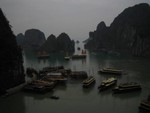 The food on board was good and we met some nice folks from Hong Kong and England who are basically semi-nomadic long-term travelers. The next morning, the weather was still gray and we toured by some Oyster farms before landing at a relatively isolated island for a brief climb and a panoramic view of the nearby islets before the boat headed back to shore and we grabbed the bus back to Hanoi. The scenery on the way back to shore was actually quite nice and we floated very close to some of the limestone cliffs. Still… we couldn’t help but feel like it was a bit of a dud. One highlight was sitting down with our guide Phong and getting some pronunciation help for the six tones of Vietnamese.
The food on board was good and we met some nice folks from Hong Kong and England who are basically semi-nomadic long-term travelers. The next morning, the weather was still gray and we toured by some Oyster farms before landing at a relatively isolated island for a brief climb and a panoramic view of the nearby islets before the boat headed back to shore and we grabbed the bus back to Hanoi. The scenery on the way back to shore was actually quite nice and we floated very close to some of the limestone cliffs. Still… we couldn’t help but feel like it was a bit of a dud. One highlight was sitting down with our guide Phong and getting some pronunciation help for the six tones of Vietnamese.
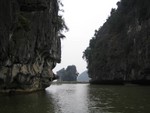 When we arrived back in Hanoi, we switched hotels. $20/night was just too rich for our blood so instead we headed for a $10/night room that was basically equivalent. We also booked a 1-day trip to Tam Coc and Hoa Lua. Hoa Lua was the ancient capital of Vietnam from the late 900s under the rule of several kings. Tam Coc is a series of karst mountains away from the ocean. Some people call it Halong Bay on land. The weather was still gray today but the trip was a lot better. Our guide gave us much more information and we had a two-hour boat ride up a river and through several large caves where the river flows. Along the way we saw locals working the fields for rice and a whole other set of locals working the river for tourists to ply their wares. Apparently there is a world-wide shortage of tablecloths and we found Tam Coc has the supply.
When we arrived back in Hanoi, we switched hotels. $20/night was just too rich for our blood so instead we headed for a $10/night room that was basically equivalent. We also booked a 1-day trip to Tam Coc and Hoa Lua. Hoa Lua was the ancient capital of Vietnam from the late 900s under the rule of several kings. Tam Coc is a series of karst mountains away from the ocean. Some people call it Halong Bay on land. The weather was still gray today but the trip was a lot better. Our guide gave us much more information and we had a two-hour boat ride up a river and through several large caves where the river flows. Along the way we saw locals working the fields for rice and a whole other set of locals working the river for tourists to ply their wares. Apparently there is a world-wide shortage of tablecloths and we found Tam Coc has the supply.
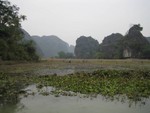 The countryside was really pretty… save the trash. There is a lot of trash here. Recycling is not a Vietnamese word yet. We regularly see piles of trash being burned next to the road. Many people wear face masks around in an attempt to filter the air they breathe but heavy coal use has left stains on everything.
The countryside was really pretty… save the trash. There is a lot of trash here. Recycling is not a Vietnamese word yet. We regularly see piles of trash being burned next to the road. Many people wear face masks around in an attempt to filter the air they breathe but heavy coal use has left stains on everything.
Despite this, people seem to be very happy. Jennifer disagrees with me citing people who look like they’re just going through the motions of their jobs (like the musicians at the water puppet theatre). But I can name just as many people back home who hate their jobs and muddle through on a day to day basis as well.
What I’ve noticed is that when the Vietnamese are sitting down with their friends and family or are chatting in the streets, there is a lot of smiling and laughter. Things here are by no means western but they are not destitute either; people seem to have enough to survive and the evolving face of the socialist government is providing opportunities for entrepreneurial and innovative people. The dream of owning a Honda scooter is becoming a reality for more and more people these days.
I’m really intrigued by Vietnam so far and I’m enjoying myself. Jennifer is feeling a little tired of places that aren’t up to her usual standards but is positive about the things we’re seeing. We’re just 5 days into a 2.5 month run from Vietnam to India so we’ll need to work on pacing ourselves.
Last note… we reconciled our spending as I mentioned in the last post and found that, to meet our budget, we need to spend $92 per day or less combined for the rest of the trip. So far in Hanoi we have spent on average ~$60/day. We’re trying to save up for our two weeks in Italy as $92USD in Euros is not going to get us very far!
Tomorrow night we hop an overnight train to Hue in Central Vietnam for a few days of touring before we carry on to Ho Chi Minh City (Saigon). Hopefully the weather will warm up!


